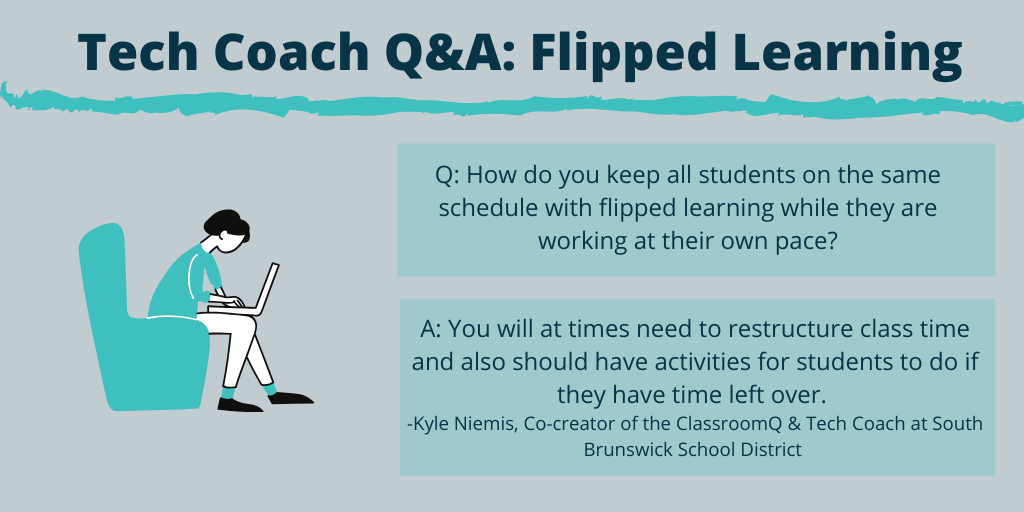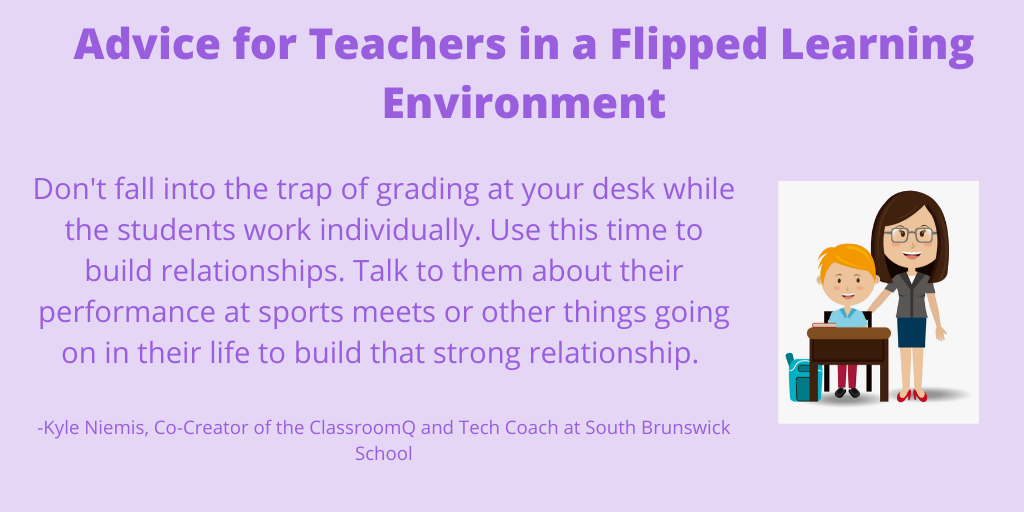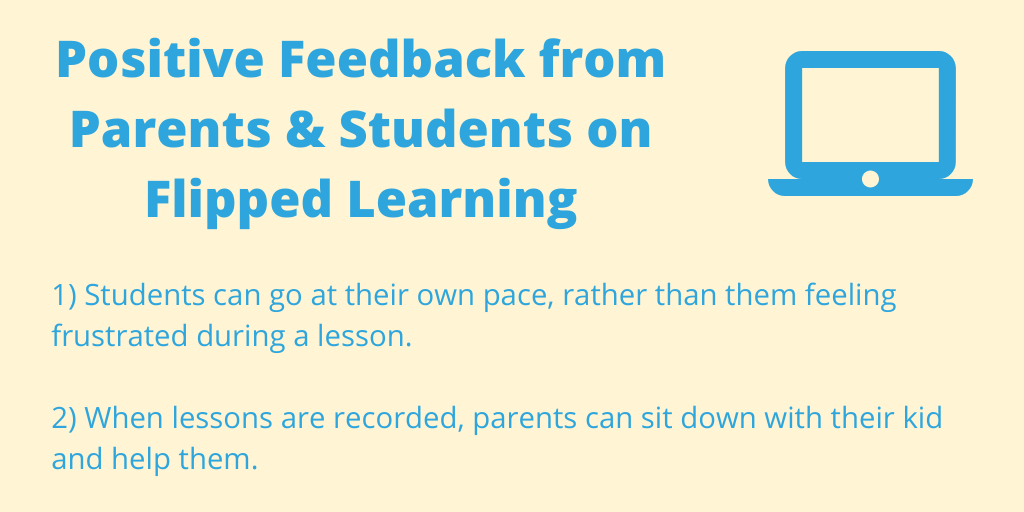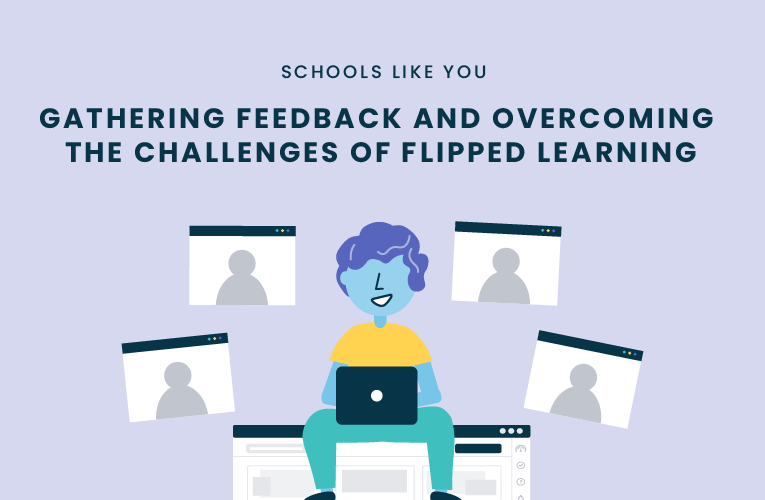Flipped learning has become a popular new style of instruction and learning that is being used by educators everywhere, and has seen a large uptick since the rise of remote learning. In a recent conversation with Kyle Niemis, Co-Creator of ClassroomQ and Tech Coach, we sat down to talk about what he has learned from his flipped learning experience, what kinds of challenges he has run into, and how he gathered feedback from parents and students.
Student Challenges with Flipped Learning
One of the biggest concerns when starting flipped learning was how receptive students, parents, and teachers would be to this new style of learning. Kyle explained that flipped learning can be hard to show teachers how to implement sometimes because there are different growing pains for every student and teacher. He shared how he would encourage students and teachers by saying, “Although there will be challenges, it will be worth it.”
Flipped learning is structured around the idea that students will start to learn for themselves while teachers take more of a guiding or coaching approach to instruction. One frequently asked question Kyle gets is: if students are working at their own pace with flipped learning, won’t some be done early and some will need more time? He explained that the answer is yes.
With a flipped learning model, the classroom setting will be restructured. More activities and back up plans will be needed for students who get their work done at an excelled rate while others continue to work on the lesson.

Kyle gave the example of an English classroom setting. With traditional lecturing, sometimes a student is ready to move on from a topic they understand but the teacher is unaware and continues to lecture the same topic for the rest of the class period.
Kyle believes that many teachers are holding students back from potential growth with traditional instruction because they don’t give students the tools to be able to dive deeper with these topics and ideas. But, if teachers provide the content in a video, then students have the choice and freedom to learn more after they’ve completed the “required” learning for that class period.
Role of the Teacher in the Flipped Learning Environment
Just like students, in the early stages, teachers also had a hard time grasping the ideas and methods of flipped learning. For a lot of teachers, this transition was very uncomfortable because they had been so used to their traditional style of teaching.
Kyle advised that teachers do not get into the habit of grading at their desk while students are watching these video lessons, but that they should enjoy the extra time they have and walk around the classroom to provide additional support. Especially if the lesson is more complex, walking around the class to answer questions and providing hands-on help can improve learning that much more.
This way you are also able to maintain relationships with your students by talking to them about their grades, homework, or other things going on in their life that help to build a strong connection.

Another way of doing this can also be assigned small groups during a lesson to show a lab or activity to those students while others continue to watch the in-class video. All in all, do the best you can to make the learning experience for students positive and effective.
Parent Feedback on Flipped Learning
In the beginning, the feedback Kyle was receiving from parents wasn’t great. At that time he was not making his own lesson videos, so he was sending his students home with videos other educators have posted to watch on YouTube. Ultimately the videos weren’t effective, the students weren’t focused, and the parents didn’t understand why they were watching YouTube as homework.
Kyle then decided to make an explanation video for parents outlining why he was doing this type of flipped learning and how they can help encourage the learning process at home. Shortly after Kyle began to make his own lesson videos which overall ended up being the key to a successful lesson.
The feedback he has received since making his own videos has been overwhelmingly positive. Parents and students have said that the benefits they found are that students are able to do a lesson at their own pace rather than feeling frustrated during a lesson because it doesn’t fit their specific needs.
They also enjoy that when lessons are recorded and distributed to watch at home, parents are able to sit down with their child and help them through the lesson when needed because the video is available for them.

Kyle said that the flipped learning style took a lot of tweaking but he finally got the positive parent feedback he was looking for. He now encourages other educators to start making their own video lessons because he has seen such great results from his own flipped learning classroom.
Listen to the full conversation with Kyle Niemis on our Tackling Tech Podcast!
This week Brett talks to Kyle Niemis, the co-creator of ClassroomQ, an Edtech Coach, and former Science teacher at South Brunswick School District in New Jersey. Kyle is passionate about flipped learning, a method of teaching where students can learn at their own pace watching videos.
Get 1 Hour of Professional Development Credit at our Coaching the Tech Coaches Workshop
Latest blog articles

Dyknow 2021 Year In Review
In addition to web browser updates and bug fixes, Dyknow released several major product updates, new features and enhancements. Check out Dyknow’s 2021 Year in Review!

The Classroom Management Tool that’s Rated #1 in Satisfaction on G2
K-12 Administrators across the world trust G2 as the #1 platform to find, research, and choose EdTech tools that solve the most pressing problems their teachers are experiencing. In G2's Fall 2021 Reports, Dyknow was once again rated #1 in overall Satisfaction out of...

Bringing Diversity and EdTech to the English Classroom
On this episode of Tackling Tech, Tierra Leustig interviews Scott Bayer about being an anti-racist teacher, diversifying reading lists, creating inclusive learning environments, and leveraging ed-tech in non-technical ELA classrooms. Scott Bayer is a High School...

